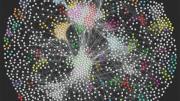Just about everything the body does depends on the interactions of proteins—the molecules encoded by genes that serve as the primary workers in cells. Without thousands of coordinating proteins, cells wouldn’t function properly; even subtle problems in these interactions can lead to disease.
Spyros Artavanis-Tsakonas, professor of cell biology at Harvard Medical School (HMS), believes that to better grasp what can go wrong with proteins, scientists need to understand how these molecules function together (not just in isolation) in healthy cells. In the October 28 issue of Cell, his team published a large-scale map that tracks the interactions of thousands of proteins in fruit flies (Drosophila melanogaster). Since then, the researchers have continued to expand the map and delve into these connections in more detail.
The map was created through a painstaking process that Artavanis-Tsakonas compares to fishing. The scientists first randomly generated thousands of distinct proteins to serve as “bait,” and introduced these proteins into Drosophila cells. When they removed the baits, they could see which proteins had adhered to them, thanks to the application of a highly precise technique, mass spectrometry, carried out by HMS professor of cell biology Steven Gygi. The result: a vast “social network” of proteins.
Although tiny fruit flies may seem to have little relevance to human disease, Artavanis-Tsakonas points out that “a lot of the basic biology is the same both in flies and humans,” and flies are far easier to manipulate and study. With the new map in hand, his lab and other researchers can study how different conditions, diseases, or other perturbations change the protein landscape. They can better investigate the thousands of proteins with as yet unknown functions by tracking their associations with known proteins. And the map may also help identify new drugs; if a protein implicated in a disease is difficult to modify with a drug, the map will allow researchers to identify alternative targets for a similar drug in a protein’s network. Although scientists have been working on similar maps, this is the largest of its kind for a complex organism. “We had enormous feedback” from other researchers about the map, Artavanis-Tsakonas says, and the data have been added to a public database for others to use.
Watch Spyros Artavanis-Tsakonas discuss how he and colleagues built a map that shows how thousands of proteins in a fruit-fly cell communicate with each other.









